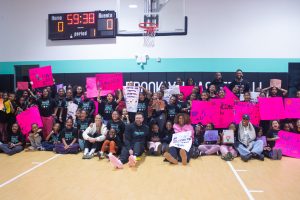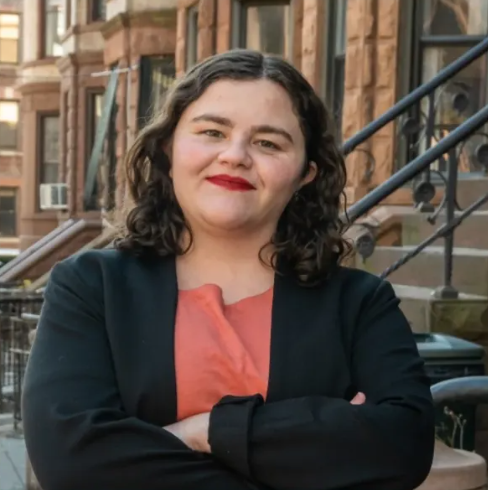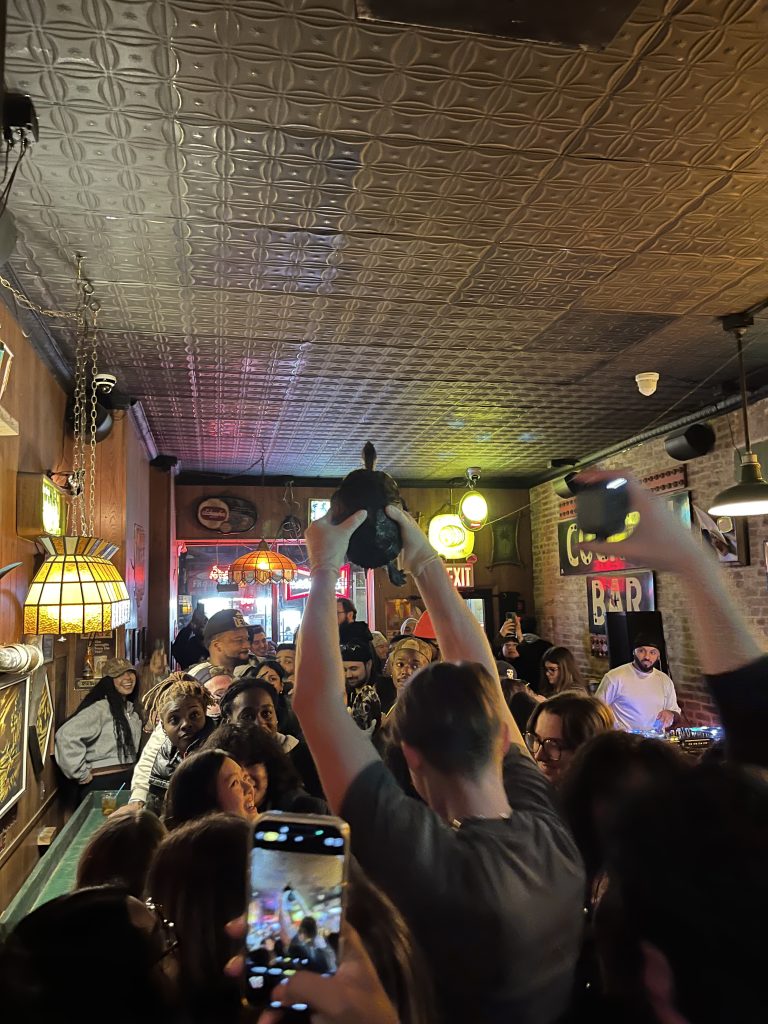JJ: “David Stearns Legacy Offseason… Loading…”
New York New York
By John Jastremski
By John Jastremski

Zuby Ejiofor leaps for the opening tip against Ole Miss just a week before the Iona matchup. The Red Storm big man recorded 8 blocks in each of the two games.
By Noah Zimmerman
noah@queensledger.com
Rick Pitino vanquished his former team on Saturday afternoon as the St. John’s Red Storm took down the Iona Gaels at Madison Square Garden, 91-64. Pitino spent three seasons in New Rochelle, leading the Gaels to two MAAC regular season titles, two conference championships, and two trips to the NCAA Tournament. The win over Iona marked Pitino’s 20th over teams he had previously coached.
“Iona is such a special place because every coach that coaches there wins. Kevil Willard started there, I certainly was rejuvenated there,” Pitino said about his former school.
Even after another slow start (this time missing 12 of their first 13 field goal attempts, St. John’s were able to outscore the Gaels 36-26 in the opening half before pulling away in the second frame.
Scoring for St. John’s was led by Oziyah Sellers with 19, though 16 of them came in the 2nd half. His strong performance led him to a spot on the BIG EAST Weekly Honor Roll.
Ian Jackson got the nod at guard over Dylan Darling for the Red Storm. It was the Sophomore transfer’s first start since the opening game of the season against Quinnipiac, and he put up a solid 14 points with 5 rebounds and a joint-team-high 3 assists. Jackson made a change of his own, chopping off his iconic hair, leading to some amusing comments by his teammates and coach.
Zuby Ejiofor was the only SJU starter to record less than 13 points, but the Red Storm big man continued his tremendous work on the defensive end with 8 blocks for a 2nd straight game. Ejiofor also pulled down a game-high 10 rebounds in the winning effort. Led by Ejiofor, the Red Storm defense is finally starting to come around as a strong point.
“We realized we weren’t a very good defensive team. Last year’s team around Christmas time wasn’t a very good defensive team either and they became one of the great defensive teams in the nation,” Pitino said about their improved effort on that end of the floor. “I think we can get to that point, we just need to keep our turnovers down because you beat yourself when you turn the ball over.”
Defense isn’t the only spot where the Red Storm needs to improve. Their inability to start games hot and inconsistent shooting will be a difficult spot as the season enters conference play and eventually the BIG EAST Tournament and beyond. If they’re unable to find consistency on that end of the floor, there’s only so much the defense can do to see out big wins down the stretch.
Following Tuesday’s contest against De Paul the Red Storm is on the road to take on the Kentucky Wildcats in the CBS Sports Classic in Atlanta. Tip off will be Saturday December 20 at 12:30pm. St. John’s comes back to Carnesecca Arena for their final game in Queens on Tuesday the 23 against Harvard.
Noah Zimmerman
noah@queensledger.com
Not many saw this trajectory coming for the Mets’ offseason, but nevertheless the core of the team has been torn apart. In the span of just weeks, New York traded their longest-tenured player in Brandon Nimmo, saw star closer Edwin Diaz sign with the back-to-back champion Dodgers, and didn’t even present a contract offer to franchise HR leader Pete Alonso, who signed in Baltimore.
It’s a complete restructuring of the team in the wake of a brutal failure last season, where they missed the postseason despite boasting MLBís second-highest payroll.
Now it’s evident that Steve Cohen and David Stearns won’t be paying more than they’re comfortable for key players, and that includes long contract terms and deferred money that ultimately led to Diaz and Alonso signing elsewhere.
“In the years that I’ve been with the Mets, I have not seen this much moving in a new direction,” said all-time great Met Kieth Hernandez.
Former manager Terry Collins shared insight on the shakeup, saying “this core has not won. Maybe it’s time to go with a different core.”
Ultimately, the bulk of the Mets’ failure last season came down to their pitching staff, one that’s only gotten weaker in recent weeks. While the offense certainly came up short more than a few times, starting pitchers consistently failed to last and the bullpen was ineffective far too often.
Now those problems are exacerbated by the loss of Diaz, Gregory Soto, and Tyler Rodgers. Additionally New York missed out on Padres reliever Robert Suarez (now with Atlanta), and still have holes to fill in their rotation.
The core certainly did not get it done, but it’s hard to see the Mets bouncing back and making the playoffs with this much upheaval in the offseason.
By Noah Zimmerman
noah@queensledger.com
The Brooklyn Nets delivered a wild smackdown to the Milwaukee Bucks on Sunday night, an impressive showing even with Milwaukee missing star big man Giannis Antetokounmpo. Their 45-point win is tied for the largest in franchise history, previously set in New Jersey back in 1993. Their previous record in the Brooklyn era came in 2022 when they defeated the Wizards by 42.
Despite the 127-point performance, no Net scored more than 17 points. Instead it was a terrific all-around performance with 9 different players scoring in double figures, including all 5 starters. Every Net recorded at least one rebound and all aside from Jalen Wilson recorded at least one assist. They beat the Bucks in both stats, also winning the battle in turnovers, blocks, steals, and fouls.
Rookie Egor Dëmin led the charge with his second-best performance in Brooklyn. His 17 points came with solid efficiency, shooting 6/8 and 3/3 at the FT line, also picking up 3 rebounds and 3 assists. While Michael Porter Jr. hit 2 of 7 three pointers and only managed 12 points (about half of his season average) the Net newcomer added 6 rebounds and 5 assists to round out his game.
The Nets were without Head Coach Jordi Fernandez, who missed the game with the flu. Assistant Steve Hetzel picked up his 1st career NBA win, echoing the same gameplan of constant ball movement and defensive effort.
“It’s a 45-point loss to a team trying to lose. They have 4 or 5 wins or whatever it is now,” lamented Bucks forward Kyle Kuzma. “That’s the beauty of this league, right? There’s so much talent and if you’re not ready you can get your butt whooped by any team.”
It was Brooklyn’s 7th win and the Bucks without Giannis certainly were not ready, though the Nets were by no means playing to lose. While they’re not constructed to contend by any means, they still have plenty of talent and when they connect on the gameplan they have shown immense promise.
Meanwhile in Milwaukee, things aren’t exactly going much better than in Brooklyn. It seems Giannis is destined for a trade in the near future and without him it’s possible the Bucks plummet from the 10th seed in the East, where they only hold a 11-16 record. If the Nets can catch their stride, especially depending on how the roster looks down the line, they could easily go on a winning stretch and find themselves in that very same play-in position.

From left to right: Liberty CEO Keia Clarke, General Manager Jonathan Kolb, Betnijah Laney-Hamilton, Nyara Sabally, Head Coach Chris DeMarco, Isabelle Harrison, Sabrina Ionescu, and Owner/Governor Clara Wu Tsai
By Noah Zimmerman
noah@queensledger.com
New York’s newest head coach landed in the city last week for an introductory press conference and youth clinic. Golden State Warriors assistant Chris DeMarco fielded questions at the Barclays Center before swapping his suit and tie for a tracksuit and heading across the street to the Brooklyn Basketball Training Center.

After his introductory press conference, DeMarco made his first appearance at the Brooklyn Basketball Training Center across the street!
After spending well over a decade in the Bay Area and helping oversee the development of one of the greatest dynasties in NBA history, DeMarco is coming to NYC, ready to set his sights on a new challenge as he becomes the 10th to lead the original WNBA franchise.
He’ll finish his assistant coaching duties with the Warriors at the end of the year, coincidentally right after they come to the Barclays Center to take on the Brooklyn Nets on December 29.

Chris DeMarco will finish his tenure with the Golden State Warriors after they visit the Brooklyn Nets at the end of December.
“We needed somebody who understands the habits that go into building a dynasty,” said General Manager Jonathan Kolb. “Someone that’s been in a championship culture and understands the cost of greatness and the accountability that’s required to sustain it.”
DeMarco is one of now seven former NBA assistants set to coach WNBA teams in 2026, joining high profile coaches like Becky Hammon, Natalie Nakase, and Nate Tibbets. It’s a strategy that has worked out well for plenty of teams, especially the Las Vegas Aces who picked up their third championship, all won under Hammon’s leadership.
The Liberty also saw their 2025 campaign ended by a star-studded team led by Tibbets, who spent 12 years as an assistant for the Cleveland Cavaliers, Portland Trailblazers, and Orlando Magic. Now New York will look to replicate the formula, also hoping to retain their top talent.
“I’m honored to be in a head coaching role in the WNBA. The league is expanding rapidly, it’s exciting and it’s where I want to be,” said DeMarco. “There’s tremendous growth each year and I get a chance to coach the greatest basketball players in the world.”

“t’s where I want to be. There’s tremendous growth each year and I get a chance to coach the greatest basketball players in the world,” said DeMarco.
Much of the offseason depends on how the collective bargaining agreement shakes out, but once that hurdle is cleared the Liberty are expected to be very aggressive in free agency to retain some stars and bolster their core.
The Liberty will not make a 1st round selection in the 2026 WNBA draft after trading their pick alongside last year’s 1st in the Natasha Cloud deal. Still, they’ll have plenty of assets and allure to bring in what they need to pursue a second title when the season tips off next year.

Lydia Green, a District Leader for the Democratic Party in northwest Brooklyn, will be primarying Jo Anne Simon for a seat in the state legislature next year. Photo: @lydiagreenbk
By JACK DELANEY | jdelaney@queensledger.com
Lydia Green, a twenty-nine-year-old organizer currently serving as a District Leader for District 52, is challenging long-time Assembly Member Jo Anne Simon for her seat in the same Brooklyn jurisdiction, which runs from DUMBO to Park Slope.
Green announced her bid on Monday, December 14, through a post on Instagram, positioning herself as an antidote to “establishment politicians” who “cater to niche interest groups rather than organizing towards the common good.”
“I grew up right here in Park Slope and am a product of Brooklyn public schools,” Green wrote. “This district is where I learned how to walk and write, multiply and march, and push for progress. But this district is also where I’ve learned how our government has failed us.”
Green is reaching the end of her two-year term as District Leader, an unpaid but elected position within the Democratic Party that focuses on grassroots outreach. Each Assembly District votes for two District Leaders — one male, one female — who help to elect county party chairs, nominate judges, choose poll workers, and organize voter registration drives.
“As a District Leader, I passed resolutions calling for single-payer health care and free public college,” said Green. “I’ll bring this same courage and energy to the Assembly.”
Green previously worked as a staffer on eight progressive campaigns, ranging from City Council to Congress. Her own candidacy comes at an inflection point for New York politics, as a new guard of young leftists seeks oust older, often more centrist leaders — and to fill the legislature with allies of Mayor-elect Zohran Mamdani. (This generational rift is a national one: A recent Harvard poll found that 57% of voters aged 18 to 42 disapproved of the Democratic Party.)
“In both the mayoral primary and general election, voters of this district have indicated that they are hungry for a bold and unapologetically progressive type of politics,” Green told the Star, noting that she would be “a true partner with our Mayor-elect to deliver on the incoming administration’s affordability agenda for western Brooklyn.”
Green’s platform rests upon three issues: taxing the rich to fund public schools and childcare, increasing the housing stock and protecting tenants, and climate-proofing this corner of Brooklyn.
“In this district, our rents have skyrocketed, the climate crisis has flooded our waterfronts, and the few have become richer at the expense of everybody else,” said Green.
District 52 encompasses many of the most heavily gentrified neighborhoods in the borough, although areas like Gowanus still carry baggage from their industrial past.
But as officials push to build hundreds of thousands of units amid a citywide housing crisis, the incumbent, former disability rights lawyer Jo Anne Simon, has taken on high-profile roles in negotiations over multi-billion dollar projects in nearby districts — chief among them the Brooklyn Marine Terminal (BMT) in Red Hook and Atlantic Yards in Downtown Brooklyn.
Simon, 73, was a founding member of BrooklynSpeaks, a community organization that has critiqued the developers of Atlantic Yards, and joined local Red Hook reps in voting against the BMT plan, saying it needed additional studies into whether the area’s sewers and roads could accommodate a major influx of residents.
Yet Green, like local Council Member Shahana Hanif, 34, who voted yes on the BMT proposal, gestured in her campaign launch at frustrations with the slow pace of development amid a citywide housing crisis.
Green, who is queer and Jewish, traces her family’s roots in Brooklyn to Bath Beach. “My ancestors came to America with very little but eventually they were able to start their own kosher butcher shop that lasted multiple generations and helped the family survive the Great Depression,” she shared in an interview with The Workers Circle.
Now seeking to represent the borough’s western shoulder, Green will look to best Simon — who came up short in a bid to become borough president in 2021, but won her latest primary in 2024 with 80% of the vote — next November, since Assembly members are elected to two-year terms without term limits.
“Whether it’s the looming threat of ICE raids, the deepening affordability crisis, or the desperate need for housing, Brooklynites need and deserve a fierce champion,” Green said on Monday. “I’m running to be that champion.”

Yongfeng Tian, a retired businessman from Bensonhurst, said his prize-winning white perch was all “luck.”
By JACK DELANEY | jdelaney@queensledger.com
Yongfeng Tian started fishing in 2015, after a friend convinced him to make the drive from Bensonhurst so they could try their luck in the reservoirs upstate.
At the boat rental shop, Tian found a book listing all of New York State’s fishing records. Many have held for decades — Northern Pike (1940), Common Carp (1995), Lake Trout (2003) — but he promised himself that his name would be in there too, one day.
“That’s been my dream,” Tian, 48, said in a phone call this week. “For 10 years, I kept fishing and fishing — it’s so hard, you know? A state record is so hard to break.”
On a breezy Sunday this past November, Tian woke up before dawn to leave Brooklyn ahead of rush hour, arriving at Cross River Reservoir in Westchester around 7 a.m. His friend had stayed home, but he wanted to be on the water; it had become a habit. He pulled out his fish finder, a sonar tool that creates an underwater map, and set out to catch some crappie or white perch.
It was a typical day: a couple bites, but nothing revolutionary. By the time 2 p.m. rolled around, Tian was getting ready to pack up. But as he angled his boat back to shore, the sensor picked up a whole school of mystery fish, 30 feet below.

Tian’s fish finder picked up a school of fish (the orange clump above) right as he was planning to head home.
Tian dropped his Jack, a popular brand of fishing lure, and immediately felt his line go taut. When he reeled it in, he was staring at a large white perch. “Wow,” he texted his friend. At home, the scales confirmed what he had suspected — his 3-pound, 4-ounce catch was a record-breaker.
“I believe that’s luck,” Tian said. “You keep fishing, and you get some luck.”
The previous record, three ounces lighter, was set in 1991 in Lake Oscaletta. According to the Department of Environmental Conservation, white perch — technically a species of bass, not perch — are commonly found throughout the state, including the Hudson River.
The DEC lists 40 fish on its recently-revamped Angler Achievement Awards Program, which now allows participants to submit entries through an app. In addition to white perch, three other records have been set this year: brook trout, fallfish, and a monstrous 37-pound, 9-ounce channel catfish.
As for Tian, his white perch is sitting in his fridge. He’s looking for a taxidermy studio that can preserve it as a trophy, in what’s known as a “skin mount.”
But even though the Bensonhurster’s decade-long dream has been realized, he plans to continue his trips to the reservoirs. When asked why, Tian is momentarily stumped. “I don’t know,” he replied. “That’s a good question.”
After a beat, the answer comes in an excited rivulet of words. “The fish, it’s so hard to get it. You study, you learn a lot, you have your experiments. You add a lot of knowledge of fish. You need to know about the fish — where they stay, what they eat. You need to know a lot of things.”
“Then you get a fish,” he said. “And when you’ve got your fish, you’re happy.”
By GEOFFREY COBB
Author, “Greenpoint Brooklyn’s Forgotten Past”
Right after Thanksgiving in Greenpoint and Williamsburg every year, the sidewalks are suddenly transformed. Hundreds of cut Christmas trees magically appear, just like mushrooms in a forest after a heavy rain. Though the trees are plentiful, they are not cheap. Tiny trees will run you $50, while a premium tree can cost up to $300! Even though the prices are high, we always buy a tree and drag it home. Decorating the tree brings back happy memories of childhood long ago and the scent that fills the house is heavenly. Please don’t remind me about the pain of cleaning the ubiquitous needles and dragging the tree out of the house at the end of the holiday!
Seeing the trees for sale waiting on snowy local sidewalks reminds me of one of the most touching chapters in the best book ever written about Brooklyn, the 1943 classic, A Tree Grows in Brooklyn. The novel is a coming-of-age story of a young local girl, Francie Nolan who grows up in the poverty of Williamsburg tenements in 1912. The novel was a huge success, and it transformed its author Betty Smith into a famous author overnight. Twentieth Century Fox acquired the rights to the book and two years later it became a box office hit that won a special Oscar award.
Smith’s chapter about Christmas in our area long ago is one of the most poignant. Francie, the protagonist and narrator, paints a vivid picture of how the struggling local population experienced Christmas long ago. Christmas trees, sadly, were a luxury many could not afford. Ten-year-old Francie excitedly tells her readers, “Christmas was a charmed time in Brooklyn.” Though they were a charmed time for local children, they were also times of great cruelty as one local ritual the narrator vividly describes proves.
Over a century ago, local sidewalks were also transformed by a salesman hawking Christmas trees. Smith tells us that spruce trees began coming into the neighborhood a week before Christmas. She relates in her novel, “There was a cruel custom in the neighborhood. It was about the trees still unsold at midnight of Christmas eve. There was a saying that if you waited until then you wouldn’t have to buy a tree, that they’d chuck ’em at you.” This was literally true.
The kids in the area gathered where there were unsold trees. The man threw each tree in turn, starting with the biggest. Kids volunteered to stand up against the biggest. If a boy did not fall under the impact of the tree, it was his.
The impoverished protagonist, Francie, age ten, and her brother Neely, age nine, volunteered to catch a tree, the biggest in the neighborhood at ten feet. The tree was so large and so expensive that it remained unsold in this area of poor people. Tiny Francie and her brother stepped up to catch the huge tree, much to the delight of the snickering residents who had gathered to watch and enjoy the cruel spectacle. The tree seller admired the bravery of the little duo and thought about just giving them the tree, but rationalized that if he gave them the tree, it would encourage people the following year to wait until midnight and not buy the trees, hurting his business. The tree salesman finally hurled the ten-foot spruce at the tiny pair and though their legs quivered, they did not buckle under the weight of the tree, and it was theirs, though being hit with the heavy spruce had left them both bruised and bloodied.
The tree salesman finished the cruel ritual by telling the battered kids,” And now get the hell out of here with your tree you lousy bastards.”
The children then eagerly dragged the large tree back to their apartment to decorate it. The readers share in the Christmas joy of the poor children who have paid such a steep price for this symbol of Christmas. The scene re-enforces the theme of the book that poverty was hard in Williamsburg, but it made the kids who suffered through it even harder.
Thankfully, over a century later our area is far richer. Thousands of locals can afford even high-priced trees, and no child is reduced to the bloody spectacle of catching an unsold Christmas tree, a fact that we can all celebrate this Christmas season

A bartender carries Ja Rule the pond turtle to the race course at Turtles All the Way Down in Bed-Stuy on Sunday.
By COLE SINANIAN | news@queensledger.com
Clad in a pair of white latex gloves, Mimi Martins smiles as she gazes into Ja Rule the pond turtle’s eyes, stroking his tummy and whispering words of tender encouragement. A barback approaches the racecourse with Vita — Ja Rule’s tank partner — held high above the heads of bargoers as they dance to Kendrick Lamar’s “Not Like Us” and shield their drinks from the dripping reptile.
With dozens of phone cameras trained on the turtles, the race begins. Vita — the younger turtle — pulls her signature move, attempting to climb over the barrier and make her escape mid-race. Martins immediately grabs the turtle and returns her to the course, but not before Ja Rule can secure a comfortable lead. Cheers erupt— a turtle has crossed the finish line. But from behind the hoards of spectators pining for a look at the action, it’s not immediately clear who won the first race. For those stuck in the packed dive bar’s far corner, Martins’ partner, Cole, walks around between races holding up a large QR code that links to a livestream of the race.
On the first Sunday of the month at Turtles All the Way Down, a popular dive bar on Malcolm X Ave in Bed-Stuy, turtles Ja Rule and Vita are the stars of what has become one of the neighborhood’s strangest and most anticipated Sunday spectacles. Now in its fifth year, the turtle races cost $5 at the door and include a free bet — a colored ticker corresponds to either Ja Rule or Vita. A winning turtle gets patrons a free drink. Before the races, Martins, who acts as emcee, stands on the bar and addresses the room with a microphone:
“It’s good to see your beautiful faces on this mild, global warming December Sunday. My name is Mimi, I’m the turtle mommy, turtle host…” Martins grins. “I don’t want to say turtle master because that sounds a little colonialist and I don’t like that.”
The turtle races start at 4pm, and by 4:30, a line has formed out the door. Get here after the second race (there are three) and the bouncer may turn you away. Spectators come from far and wide. During her first pre-race speech, Martins gets a read of the room’s occupants; there’s a group of Londoners, a man from Atlanta. In the past, she said, large groups from Spain and Mexico have attended the races.
“I need camaraderie! I need kinship!” Martins says into the microphone. “Make new friendships! Hell, kiss somebody you don’t know.” Someone shouts from the crowd: “With consent!” “With consent,” Martins affirms.
The bar’s turtle theme came more or less spontaneously. According to a manager who gave his name as Lean Automatic, the name was the idea of a former manager who had read the John Green book, “Turtles All the Way Down.”
“They were just kind of throwing stuff around,” Automatic said. In epistemology — the study of knowledge — the phrase refers to the problem of infinite regress, or that any statement and its justification can be infinitely questioned. The phrase also alludes to the “World Turtle” of Hindu and Indigenous American mythology, upon whose back the universe rests.
Turtles, which opened back in 2017, is one of a dozen bars throughout the city owned by the same company. Some, like Turtles and sister Bed-Stuy bar, Do or Dive, keep a deliberately eclectic, antique-shop-esque interior design. At Turtles, taxidermied fauna adorn the walls, including a hammerhead shark (Automatic says it’s real), an inflated pufferfish, and an elk head pinned above the bar that came from a taxidermist that Automatic insists killed the animal himself.
“A lot of our bars are dressed with the same kinds of antiques, like vintage stuff,” he said. “We got guys that help us dress our bars. We got connections. So we got guys who do taxidermy, we got a taxidermist. We got a light guy.”
For the first few years, the fish tank held just fish. But after Ja Rule and Vita — named for the iconic New York-area rappers — were gifted to the bar, the owners suggested racing them once a month. Automatic, who was back then a DJ at Turtles, said the staff was initially hesitant. But the event gained popularity, even going viral on TikTok earlier this year, which Automatic and Martins say is why so many foreigners come to the turtle races. It’s all part of a unique aesthetic of liquor-soaked marine mischief, what a former manager once described as “aquarium dancehall,” Automatic said.
“It’s our little aquarium and place to dance around.”
People have called the bar with animal rights concerns, although Martins said these concerns usually come from ignorance. The turtles’ ears are internal, meant to pick up low-frequency sounds, so the loud noise of the rowdy drinkers is unlikely to disturb them.
“It sounds like a low humming to them,” Martins said. “We did some research and learned all this. Their eyes are very sensitive, they know who I am, they have really amazing vision.” This is why flash photography is strictly prohibited, grounds for removal from the festivities, as Martins made clear in her pre-race speech.
“I would die for them, straight up,” Martins said. I’m like, ‘oh my God, it’s our fifth anniversary Ja Rule.”

Travis Gale of Eyes of the Wild releases Dillon the Armadillo into a room of screaming pre-schoolers during an exhibition on December 2.
By Cole Sinanian
news@queensledger.com
“This is a full-grown elephant.”
Travis Gale pauses for effect, holding up the back of the leopard-print blanket that covers the cage, its mysterious contents visible only to him.
“BBRRRRRAAA!” His elephant trill is impressive. The dozen or so four-year-old Brooklyn Preschool of Science students seated criss-cross apple sauce around him scream and giggle in delight.
Gale pulls out one strip of newspaper, then another, relishing the suspense.
“WE WANT TO SEE THE AMINAL!” shrieks a little blonde boy named Henry.
Finally, out of the cage comes Dillon the six-banded armadillo. Gale takes care to explain to the children the difference between Dillon and other kinds of armadillos. There’s giant armadillos, nine-banded armadillos, and of course, the pink fairy armadillo of Argentina. Dillon, who Gale rescued from the exotic pet trade, is tortoise-sized with a hard, ridged shell covered in wispy long hairs.
“Imagine your whole back is covered in toenails,” Gale said.
“BE CAREFUL WITH THE AMINAL!” responded Henry.
It’s clear Gale spends much of his time speaking in the register of children. “Good morning, toys and swirls,” he tells the kids before unveiling Dillon. He addresses them as “baby goats,” a kind of animal also known as a “kid.” As founder of Eyes of the Wild — an exotic animal rescue center based on a farm in Hunterdon County, New Jersey — Gale has been coming to Brooklyn Preschool of Science for the past eight years, bringing a different cast of creatures each time. Last year, he brought a wallaby. A few years before he brought a sugar glider, a kind of gliding possum native to southeastern Australia, and launched it at Miranda DeMartin, the school’s educational director.
“As a science school, we’re always trying to figure out ways to incorporate different kinds of sciences,” DeMartin said. “And children at this age, they have no fear of worms or snakes or animals.”
A visit from Gale and his furry friends fits nicely into the school’s educational programming. With locations in Cobble Hill, Park Slope, and Boerum Hill, Brooklyn Preschool of Science offers an interactive, activity-based curriculum where children’s innate curiosity is cultivated as a precursor to scientific inquiry. As DeMartin explained, interaction with the natural world is crucial to BPS’ curriculum. Pet guinea pigs, hermit crabs and frogs are kept in classrooms. In the Cobble Hill location’s entrance hallway, where Gale’s presentation took place, a giant sperm whale is painted on the wall. Each year, children hatch a cohort of classroom chickens and care for the young chicks, part of a study of the life cycle. In January, DeMartin says, the school will host a “bubble show” as part of its unit on states of matter.